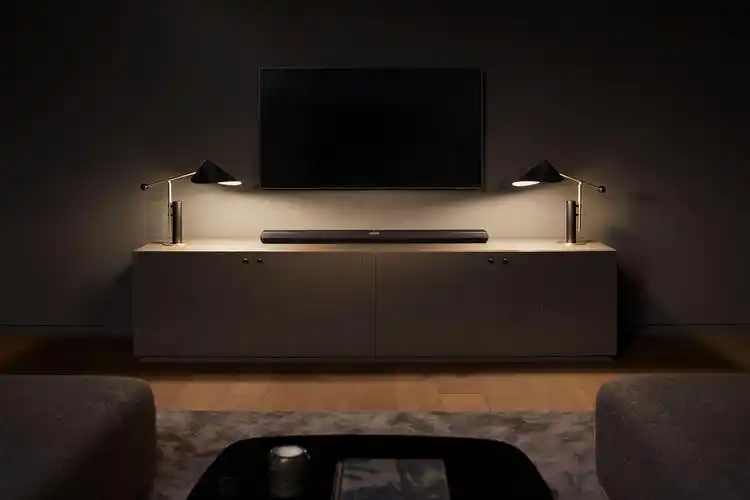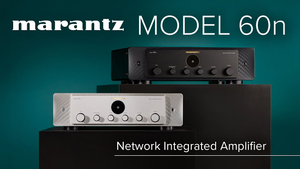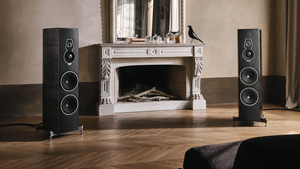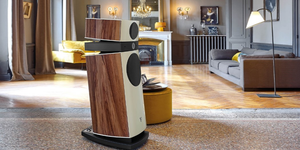
Bowers & Wilkins Panorama 3 Review
I. Overture: A Legacy in a Single Bar
In the world of high-fidelity audio, few names command the reverence of Bowers & Wilkins. It is a marque synonymous with acoustic precision, a brand whose engineering prowess is trusted in the hallowed halls of Abbey Road Studios and whose iconic 800 Series loudspeakers stand as benchmarks of sonic artistry. It is from this unimpeachable legacy that the Panorama 3 soundbar emerges. This is not merely another entry into a crowded market; it is a statement of intent. The Panorama 3 is B&W's answer to the modern demand for convenience and minimalist design, but executed through the uncompromising lens of a purist, audiophile philosophy.

At its core, this product presents a fascinating philosophical conflict. The prevailing trend in the premium soundbar category, championed by tech-forward companies like Sonos, is one of modularity and endless expansion—the ability to add subwoofers and surround speakers over time to build a comprehensive home cinema system. Bowers & Wilkins has taken a deliberately contrary path. The Panorama 3 is a staunchly self-contained, all-in-one proposition: what you buy is the complete, final system. This is not an oversight but a calculated decision, a belief that a single, meticulously tuned component can offer a more cohesive and aesthetically pleasing experience than a multi-box setup that risks becoming sonically disjointed. The Panorama 3 thus poses a fundamental question to the modern audiophile: in an age of perpetual upgrades and expandability, is there still a place for elegant, perfected simplicity?
II. Form and Function: A Study in Understated Elegance
The physical presence of the Panorama 3 is a masterclass in sophisticated restraint. Its most striking characteristic is its remarkably low profile. Measuring a mere 6.5 cm (approximately 2.5 inches) in height, it is engineered to sit discreetly beneath the screen of most contemporary televisions without obstructing the view—a practical and aesthetic triumph in a field of often bulky competitors. This svelte form is wrapped in premium materials, with a seamless acoustic cloth covering the front and sides, complemented by a perforated metal top grille that speaks to its quality construction.
Interaction is handled with a similar flair for minimalism. The top surface features a dark glass panel with capacitive touch controls that are "hidden-until-lit," awakening with a wave of the hand. While this feature enhances the bar's clean lines, the glossy surface is, predictably, a magnet for fingerprints. Some may find the overall design—a long, subtly convex bar—somewhat nondescript when compared to the brand's more avant-garde creations like the Zeppelin speaker. However, this understated approach serves a clear purpose: to integrate into a living space with quiet confidence rather than demanding attention. Its substantial weight of 6.5 kg (14.3 lbs) and the palpable rigidity of its chassis provide a tactile confirmation of the excellent build quality within.
This celebrated design, however, is the source of the product's primary sonic trade-offs. The decision to prioritize an ultra-low profile is an intentional aesthetic choice, but one that brings with it the unyielding constraints of physics. Creating a truly expansive, three-dimensional sound field, particularly the convincing overhead effects of Dolby Atmos, requires a certain cabinet volume and specific driver geometry that a slim form factor inherently limits. As listening tests reveal, this direct link between the bar's elegant form and its more modest immersive performance is the central compromise at the heart of the Panorama 3's design.

III. The Acoustic Architecture: A Self-Contained Orchestra
Beneath its refined exterior lies a formidable acoustic engine. The Panorama 3 is engineered as a discrete 3.1.2 channel system, driven by a potent 400 watts of total Class-D amplification. This power is distributed among 13 individual drivers, each painstakingly positioned to fulfill a specific role in the sonic presentation.
Left, Center, and Right Channels
The foundation of the soundbar's performance rests on its three discrete front-firing arrays. Each of the left, center, and right channels is equipped with two 50 mm (2-inch) woven glass-fiber midrange drivers, partnered with a 19 mm (0.75-inch) titanium-dome tweeter. Crucially, these tweeters are decoupled from the main baffle—a signature B&W engineering technique borrowed from its high-end loudspeakers, designed to minimize cabinet vibrations and deliver cleaner, more detailed high frequencies.
Low-Frequency Effects (.1)
In a bold move to maintain its all-in-one design, B&W has integrated the subwoofer directly into the chassis. Two custom-designed 100 mm (4-inch) long-throw woofers are mounted on the top surface, firing upwards into a large, sealed acoustic enclosure that constitutes the majority of the cabinet's internal volume. This clever arrangement, combined with digital signal processing (DSP), allows the Panorama 3 to achieve a claimed low-frequency extension down to an impressive 43 Hz, negating the need for a separate, room-cluttering subwoofer.
Height Channels (.2)
To deliver the vertical dimension of Dolby Atmos, the Panorama 3 employs two 50 mm (2-inch) woven glass-fiber drivers. These are set at a carefully calculated angle on the top surface, designed to reflect sound off the ceiling and back down to the listening position, creating the sensation of overhead audio.
The hardware itself reveals where B&W's engineering priorities lay. The investment in the front-firing LCR array—nine high-quality drivers featuring premium materials and advanced design principles—is substantially more robust than the minimalist two-driver solution for height and surround effects. This architectural choice heavily favors direct, forward-firing sound, a clear nod to the brand's Hi-Fi heritage. It suggests a focus on perfecting core stereo and center-channel performance for music and dialogue, while incorporating Atmos as a feature to meet market expectations, but without the same level of psychoacoustic investment as competitors.
IV. The Listening Room: Cinematic Immersion
Putting the Panorama 3 to the test with a range of cinematic content reveals a performance of distinct character, with clear strengths and equally clear limitations.
The Soundstage and The Atmos Question
The Panorama 3 generates a soundstage that is wide, detailed, and solidly defined, extending slightly beyond the physical edges of the bar. However, its presentation is largely anchored to the front of the room. It lacks the wall-to-wall expansiveness and immersive envelopment offered by rivals like the Sonos Arc, a limitation directly attributable to its absence of side-firing drivers, which are crucial for creating a sense of width and side-surround effects.
When it comes to Dolby Atmos, the performance is best described as subtle. During test scenes with distinct overhead cues, such as the persistent rain in Blade Runner 2049, the Panorama 3 provides a discernible "suggestion" of height, adding a sense of atmosphere and space to the sound field. Yet, it falls short of creating a convincing overhead canopy of sound. Effects do not feel as if they are truly emanating from the ceiling; rather, they seem to float a few feet above the soundbar itself. For those seeking the most dramatic and transportive Atmos experience, the Panorama 3's verticality may feel underwhelming.
Dialogue, Detail, and Dynamics
Dialogue clarity is perhaps the most contentious aspect of the Panorama 3's performance, with reports varying significantly. In some listening environments, dialogue is rendered with excellent clarity and naturalism, positioned clearly within the soundstage. In others, particularly during complex action sequences where dialogue competes with music and effects, speech can sound somewhat "closeted" or muffled, lacking sparkle and presence. This inconsistency is not likely a fault of the hardware itself, but rather a direct consequence of the bar's purist approach to processing. The Panorama 3 offers no form of automated room correction software (such as Sonos Trueplay or Bose ADAPTiQ) and only basic bass and treble adjustments. In an acoustically favorable room, the bar's natural voicing shines. However, in a more typical living space with reflective surfaces, the same tuning can fall victim to room-induced acoustic issues, leading to the reported lack of clarity. The user experience is therefore highly dependent on the listening environment, a variable that its competitors actively seek to neutralize through software.
In terms of dynamics, the Panorama 3 is confident and controlled. It handles the dramatic shifts from quiet whispers to explosive set-pieces with composure, delivering punch and impact without becoming unbalanced. However, in the most chaotic scenes, some reviews note that the imaging can become a bit cluttered as various sonic elements vie for space.
The Foundation of Bass
The performance of the integrated woofers is a highlight. The Panorama 3 delivers a low-frequency response that is impressively tight, articulate, and speedy for an all-in-one unit. Explosions and percussive effects are rendered with a taut precision that is often missing from soundbars that rely on boomy, less-controlled bass. This is "audiophile bass"—prioritizing quality, texture, and control over sheer quantity. While it provides a satisfying and weighty foundation, it cannot defy physics entirely. It lacks the visceral, room-shaking depth and sub-sonic rumble that a dedicated, high-quality subwoofer can provide, and may feel less powerful than competitors with larger integrated drivers, like the Sony HT-A7000.
V. A Musical Interlude: The Hi-Fi Heart
If the Panorama 3's cinematic performance is a story of elegant compromise, its musical performance is one of unqualified success. When the task shifts from creating an immersive bubble of sound to reproducing a stereo music track, the bar's limitations fade away and the quality of its front-firing driver array comes to the fore. This is where the Panorama 3 truly feels like a Bowers & Wilkins product.
Evaluated with high-resolution tracks streamed via the integrated B&W Music App (which supports services like Tidal and Qobuz) and over a high-quality Bluetooth connection supporting aptX Adaptive, the soundbar proves to be a genuinely accomplished music system. The tonal balance is natural and convincing, from the quick, detailed low frequencies to the spacious, eloquent midrange and the crisp, substantial top end. Stereo imaging is excellent, creating a wide and well-defined soundstage that allows instruments and vocals to occupy their own distinct space. It handles complex rhythms with confidence and a sense of "sinuousness," demonstrating a rhythmic drive and cohesion that eludes many of its cinema-focused competitors. In this domain, the Panorama 3 not only competes with but often surpasses its rivals, delivering a superb and engaging listening experience that honors the brand's esteemed musical heritage.
This stellar musicality reframes the product's entire identity. It is perhaps best understood not as a cinema-first soundbar that happens to play music well, but as a music-first Hi-Fi system, packaged in a soundbar form factor, that is also highly capable of enhancing television and movie audio.
VI. The Competitive Landscape: A Crowded Stage
To fully appreciate the Panorama 3's unique position, it must be contextualized against its key rivals. Its price point places it in direct competition with some of the most popular and well-regarded soundbars on the market.
Table: Feature and Specification Showdown
| Feature | Bowers & Wilkins Panorama 3 | Sonos Arc | Sony HT-A7000 |
| Price (USD/GBP) | $999 / £899 | $899 / £899 | $1,399 / £1,299 |
| Channel Config. | 3.1.2 | 5.0.2 (Virtual) | 7.1.2 (Virtual) |
| Driver Complement | 3x Tweeters, 6x Midrange, 2x Woofers, 2x Up-firing | 3x Tweeters, 8x Woofers (incl. Up/Side-firing) | 2x Tweeters, 5x Full-Range, 2x Up-firing, 2x Beam Tweeters |
| Total Power | 400 W | Not Disclosed | 500 W |
| Dimensions (HxWxD) | 2.6 x 47.6 x 5.5 in | 3.4 x 45 x 4.5 in | 3.2 x 51.2 x 5.6 in |
| HDMI eARC | Yes (1 input) | Yes (1 input) | Yes (1 output, 2 inputs) |
| HDMI Passthrough | No | No | Yes (8K/4K120) |
| Wireless Support | Wi-Fi, AirPlay 2, Spotify Connect, Bluetooth (aptX Adaptive) | Wi-Fi, AirPlay 2, Spotify Connect | Wi-Fi, AirPlay 2, Spotify Connect, Chromecast, Bluetooth (LDAC) |
| Voice Assistant | Amazon Alexa | Amazon Alexa, Google Assistant | Amazon Alexa, Google Assistant |
| Room Correction | No | Yes (Sonos Trueplay) | Yes (Sound Field Optimization) |
| Expandability | No | Yes (Subwoofer, Surrounds) | Yes (Subwoofer, Surrounds) |

The Arch-Rival: vs. Sonos Arc
The comparison with the Sonos Arc is a tale of two fundamentally different philosophies. The Arc is built for immersion and ecosystem. Its use of side-firing drivers, combined with effective processing, creates a demonstrably wider and more enveloping soundstage for movies. Its key advantage lies in software, with Trueplay room correction tuning the sound specifically for your space—addressing the very inconsistencies noted in the Panorama 3's dialogue performance—and a mature, robust multi-room ecosystem. The Panorama 3 counters with what many find to be a more articulate and "faster" bass response and superior musical fidelity. It also includes Bluetooth connectivity, a feature notably absent from the Arc. The choice is stark: the Arc offers greater cinematic immersion and a future-proof upgrade path, while the Panorama 3 offers superior musicality and the purity of a single, elegant component.
Scaling the Heights: vs. Sony HT-A7000 and Sennheiser Ambeo
Looking at higher-priced competitors further clarifies the Panorama 3's niche. The Sony HT-A7000, with its 7.1.2 channel configuration, more powerful bass, broader format support (including DTS:X), and crucial inclusion of HDMI passthrough, demonstrates what a step-up in price affords in terms of features and immersive capability. At the top of the single-bar market, the Sennheiser Ambeo Max stands as the benchmark for sheer immersive power and sonic scale, operating in a different performance class altogether. These comparisons are not to fault the Panorama 3, but to define it. It is not attempting to be the most immersive home cinema solution; it is aiming to be the most musical and elegant soundbar at its price point.

VII. Final Verdict: An Elegant Compromise
The Bowers & Wilkins Panorama 3 is a product of profound conviction and elegant compromise. It is a beautifully crafted, musically gifted soundbar that deliberately forgoes the ultimate in cinematic immersion and the flexibility of expansion in favor of aesthetic purity, audiophile-grade musicality, and operational simplicity.
Its strengths are considerable and will be deeply appealing to a specific type of listener. It offers a superb, engaging performance with music that honors the B&W name. Its integrated bass is tight, controlled, and articulate. Its design is a masterclass in understated, premium minimalism that will complement any modern living space.
However, its weaknesses are equally clear and cannot be ignored. The Dolby Atmos effects are subtle rather than spectacular, and the soundstage, while detailed, remains constrained to the front of the room. The lack of room correction makes its dialogue clarity dependent on the acoustics of your space, and the complete absence of an upgrade path is a significant limitation in a competitive market.
The ideal owner for the Panorama 3 is a discerning listener who prioritizes music fidelity and minimalist design above all else. This individual is likely an admirer of the Bowers & Wilkins house sound, seeking a simple, one-box solution to dramatically improve their television's audio, but intends to use the system as much, if not more, for listening to music. For this person, the Panorama 3 is a uniquely compelling and satisfying proposition.
Conversely, for the dedicated home cinema enthusiast—the movie lover seeking to build a truly immersive surround system over time, or for whom the most dramatic Atmos effects are paramount—their investment would be better placed elsewhere. More flexible and immersive alternatives like the Sonos Arc, or more feature-rich and powerful solutions like the Sony HT-A7000, would be a more suitable choice. The Panorama 3 is not a soundbar for everyone, but for the purist it targets, it is a beautifully executed statement of principle.






Comments